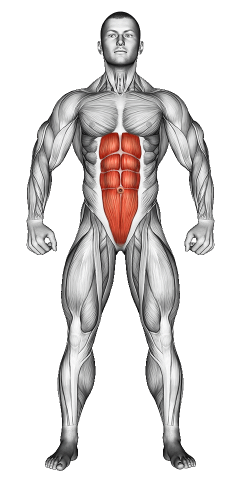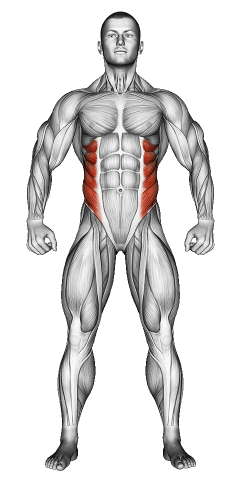Standing Oblique Crunches: Video Tutorial & Exercise Guide

Written By: Claude Michael
Updated: Oct 13, 2024
| Workout | Standing Oblique Crunches |
| Primary Muscle Group | Abs |
| Secondary Muscle Group | Obliques |
| Equipment Required | Bodyweight |
| Force Type | N/A |
| Mechanics | Compound |
| Exercise Type | Strength |
| Difficulty | Intermediate |
Standing Oblique Crunches: Video Tutorial & Exercise Guide
- 1.Standing Oblique Crunches: Muscle Groups
- -1.1Primary Muscle Group
- -1.2Secondary Muscle Group
- 2.Standing Oblique Crunches: Step-by-Step Guide
- 3.Standing Oblique Crunches: Overview
- 4.Standing Oblique Crunches: Benefits
- 5.Standing Oblique Crunches: Pro Tips & Advanced Techniques
- 6.Standing Oblique Crunches: Progression Plan
- 7.Standing Oblique Crunches: Frequently Asked Questions (FAQs)
Secondary Muscles Group
Standing Oblique Crunches: Step-by-Step Guide
- Step 1: Stand tall with your feet shoulder-width apart, and place your hands behind your head with your elbows flared out to the sides. Keep your chest lifted and your core engaged.
- Step 2: Shift your weight onto one leg and lift your opposite knee toward your elbow while simultaneously crunching your torso to that side. Squeeze your obliques as you bring your knee and elbow togClaude.
- Step 3: Lower your leg and return to the starting position in a controlled motion, keeping your core engaged.
- Step 4: Repeat the movement on the same side for the desired number of reps before switching to the other side.
- Step 5: Continue alternating sides until you complete the set, focusing on smooth, controlled movements and engaging your obliques throughout.
Standing Oblique Crunch: Overview
Standing Oblique Crunches are a dynamic core exercise that primarily targets the obliques, while also engaging the hip flexors, lower abs, and stabilizing muscles. Unlike traditional crunches, this exercise is performed while standing, making it easier on the lower back while allowing for more functional movement.
This exercise can be done anywhere, with no equipment needed, and is suitable for all fitness levels. It’s perfect for adding core training to any workout routine, whether you’re at the gym or at home.
Standing Oblique Crunches: Benefits
Standing Oblique Crunches strengthen and tone the obliques, improving core stability and balance. By working in a standing position, this exercise also engages stabilizing muscles in the legs and lower back, providing a full-body challenge.
Regularly incorporating this movement into your routine can enhance posture, improve flexibility in the spine, and promote better core control, all while reducing the strain on your neck and lower back compared to traditional crunches.
Standing Oblique Crunch: Pro Tips & Advanced Techniques
To maximize the effectiveness of the Standing Oblique Crunch, focus on engaging your core and obliques throughout the entire movement. Avoid pulling your neck or leaning too far forward. For added difficulty, you can hold a dumbbell in one hand while crunching to that side or add a slow, controlled tempo to increase time under tension.
Standing Oblique Crunches: Progression Plan
Beginner
Intermediate
Advanced
Standing Oblique Crunches: Frequently Asked Questions (FAQs)
What muscles do standing oblique crunches work?
+Standing Oblique Crunches primarily target the obliques but also engage the lower abs, hip flexors, and stabilizing muscles in the legs and core.
Are standing oblique crunches good for beginners?
+Yes, this exercise is beginner-friendly and can be performed without weights. Focus on proper form and core engagement before progressing to advanced variations.
How often should I do standing oblique crunches?
+Include Standing Oblique Crunches in your core routine 2-3 times per week. Combine them with other core exercises for a balanced workout.
What common mistakes should I avoid?
+Avoid pulling on your neck or leaning too far forward. Focus on engaging your obliques and using controlled, smooth movements throughout the exercise.
Can I use weights during standing oblique crunches?
+Yes, you can hold a dumbbell in one hand to increase resistance and challenge your obliques further. Start light and increase the weight as your core strengthens.
Share
Don’t Wish for It, Work for It – Join the FlexXP Newsletter Today!
Thank you for signing up for the FlexXP Newsletter!
This site is protected and the Google Privacy Policy and Terms of Service apply.

